Evaluation of Human Health Risks Associated with Groundwater Contamination and Groundwater Pollution Prediction in a Landfill and Surrounding Area in Kaifeng City, China
Abstract
:1. Introduction
2. Overview of the Study Area
3. Materials and Methods
3.1. Monitoring Point Placement and Sample Testing
3.2. Groundwater Quality Evaluation
3.3. The Evaluation Methodology of Health Human Risks Arising from Groundwater Contamination
3.3.1. Hazard Identification
3.3.2. Exposure Assessment
3.3.3. Toxicity Assessment
3.3.4. Risk Characterization
3.4. Hydrogeological Modeling Methods
3.4.1. Hydrogeological Conceptual Model
3.4.2. Conceptual Model of Groundwater Contamination
4. Results and Discussion
4.1. Water Chemistry Characteristics
4.2. Groundwater Quality Evaluation Results
4.3. Health Risk Evaluation Results
4.4. Numerical Groundwater Model
4.5. Pollution Prediction
- Sustained release: assuming the pollution source was not treated during the prediction period, pollutants were continuously released into groundwater. The maximum range of impact and concentration distribution characteristics of the predicted pollutants were simulated to provide a basis for pollution prevention and control.
- Intensive monitoring: assuming that the frequency of water sample testing of monitoring wells near the source of pollution occurs once per month, the discovery of pollution exceeds the standard time needed to take mitigating measures, which simulates the prediction of the impact of encrypted detection conditions and concentration distribution characteristics of pollutants. The finding provides a basis for monitoring design and pollution prevention.
5. Conclusions
- (1)
- The groundwater in the study area is neutral, the groundwater is held as pore water, its water chemistry is of the HCO3−—Ca·Na type, and the overall total dissolved solids amount to less than 1 g/L;
- (2)
- According to the EWQI calculation results, the overall water quality in the study area is above the medium level, and the local water quality level is poor. Analyzing the causes, the groundwater in the study area was found to be mainly contaminated by NH4+-N and Mn. Due to the presence of farmed land around the upstream wells, the increase in the concentration of groundwater NH4+-N was caused by the result of long-term fertilization; other wells downstream were also contaminated to varying degrees and so it was determined that the leachate discharged from the landfill pile may have been the cause;
- (3)
- Using the health risk evaluation model, the non-carcinogenic risks of NH4+-N and Mn in the study area were evaluated mainly through two routes: oral ingestion of groundwater and dermal contact. The HQs at all monitoring sites were less than 1, indicating that their potential risks could be ignored;
- (4)
- Under the continuous release scenario of pollutants, a Pb pollution plume in the groundwater flow field was driven by continuous diffusion to the east of the downstream area, which exceeded the standard pollution plume area and continued to increase. The process successively caused the fish ponds, and farmland groundwater quality to exceed Class III water quality limits. After 20 years, it spread 347.82 m to the east, and the area of exceedance reached 204,830 m2;
- (5)
- Intensive monitoring was able to detect contaminant leaks in time and mitigate the impact on downstream groundwater. Under monthly monitoring, contaminant leakage was detected and measures were taken timeously, and the maximum concentrations of the leaked contaminants and the area of exceedance were gradually reduced over time, and the contaminant plume was moved 338.21 m (at its greatest extent) to the east after 20 years, while the area of exceedance was reduced to 44,255 m2.
Author Contributions
Funding
Institutional Review Board Statement
Informed Consent Statement
Data Availability Statement
Conflicts of Interest
References
- Wang, K.; Reguyal, F.; Zhuang, T. Risk assessment and investigation of landfill leachate as a source of emerging organic con-taminants to the surrounding environment: A case study of the largest landfill in Jinan City, China. Environ. Sci. Pollut. Res. 2021, 28, 18368–18381. [Google Scholar] [CrossRef]
- Parvin, F.; Tareq, S.M.; Parvin, F.; Tareq, S.M. Impact of landfill leachate contamination on surface and groundwater of Bangladesh: A systematic review and possible public health risks assessment. Appl. Water Sci. 2021, 11, 100. [Google Scholar] [CrossRef]
- Chaudhary, R.; Nain, P.; Kumar, A. Temporal variation of leachate pollution index of Indian landfill sites and associated human health risk. Environ. Sci. Pollut. Res. 2021, 28, 28391–28406. [Google Scholar] [CrossRef] [PubMed]
- Sanga, V.F.; Fabian, C.; Kimbokota, F. Heavy metal pollution in leachates and its impacts on the quality of groundwater resources around Iringa municipal solid waste dumpsite. Environ. Sci. Pollut. Res. 2023, 30, 8110–8122. [Google Scholar] [CrossRef] [PubMed]
- Troudi, N.; Tzoraki, O.; Hamzaoui-Azaza, F.; Melki, F.; Zammouri, M. Estimating adults and children’s potential health risks to heavy metals in water through ingestion and dermal contact in a rural area, Northern Tunisia. Environ. Sci. Pollut. Res. 2022, 29, 56792–56813. [Google Scholar] [CrossRef] [PubMed]
- Reshadi, M.A.M.; Soleymani Hasani, S.; Nazaripour, M.; McKay, G.; Bazargan, A. The evolving trends of landfill leachate treatment research over the past 45 years. Environ. Sci. Pollut. Res. 2021, 28, 66556–66574. [Google Scholar] [CrossRef]
- Gupta, V.; Kumar, D.; Dwivedi, A.; Vishwakarma, U.; Malik, D.S.; Paroha, S.; Gupta, N. Heavy metal contamination in river water, sediment, groundwater and human blood, from Kanpur, Uttar Pradesh, India. Environ Geochem Health. 2022. [Google Scholar] [CrossRef]
- Lee, S.W.; Cho, H.G.; Kim, S.O. Comparisons of human risk assessment models for heavy metal contamination within abandoned metal mine areas in Korea. Environ. Geochem. Health 2019, 41, 481–505. [Google Scholar] [CrossRef]
- Alsubih, M.; El Morabet, R.; Khan, R.A.; Khan, N.A.; ul Haq Khan, M.; Ahmed, S.; Changani, F. Occurrence and health risk assessment of arsenic and heavy metals in groundwater of three industrial areas in Delhi, India. Environ. Sci. Pollut. Res. 2021, 28, 63017–63031. [Google Scholar] [CrossRef] [PubMed]
- Alidadi, H.; Tavakoly Sany, S.B.; Zarif Garaati Oftadeh, B.; Mohamad, T.; Shamszade, H.; Fakhari, M. Health risk assessments of arsenic and toxic heavy metal exposure in drinking water in northeast Iran. Environ. Health Prev. Med. 2019, 24, 59. [Google Scholar] [CrossRef]
- Li, L.; Wang, S.; Shen, X.; Jiang, M. Ecological risk assessment of heavy metal pollution in the water of China’s coastal shellfish culture areas. Environ. Sci. Pollut. Res. 2020, 27, 18392–18402. [Google Scholar] [CrossRef]
- Wang, Z.; Qin, H.; Liu, X. Health risk assessment of heavy metals in the soil-water-rice system around the Xiazhuang uranium mine, China. Environ. Sci. Pollut. Res. 2019, 26, 5904–5912. [Google Scholar] [CrossRef]
- Khalid, S.; Shahid, M.; Shah, A.H.; Saeed, F.; Ali, M.; Qaisrani, S.A.; Dumat, C. Heavy metal contamination and exposure risk assessment via drinking groundwater in Vehari, Pakistan. Environ. Sci. Pollut. Res. 2020, 27, 39852–39864. [Google Scholar] [CrossRef]
- Petrosyan, V.; Pirumyan, G.; Perikhanyan, Y. Determination of heavy metal background concentration in bottom sediment and risk assessment of sediment pollution by heavy metals in the Hrazdan River Armenia. Appl. Water Sci. 2019, 9, 102. [Google Scholar] [CrossRef]
- Duvva, L.K.; Panga, K.K.; Dhakate, R.; Himabindu, V. Health risk assessment of nitrate and fluoride toxicity in groundwater contamination in the semi-arid area of Medchal, South India. Appl. Water Sci. 2022, 12, 11. [Google Scholar] [CrossRef]
- Kazemi, A.; Esmaeilbeigi, M.; Sahebi, Z.; Shooshtari, S.J. Hydrochemical evaluation of groundwater quality and human health risk assessment of trace elements in the largest mining district of South Khorasan, Eastern Iran. Environ Sci Pollut Res. 2022, 29, 81804–81829. [Google Scholar] [CrossRef]
- He, L.; Tu, C.; He, S.; Long, J.; Sun, Y.; Sun, Y.; Lin, C. Fluorine enrichment of vegetables and soil around an abandoned aluminium plant and its risk to human health. Environ. Geochem. Health 2021, 43, 1137–1154. [Google Scholar] [CrossRef]
- Soto-Jiménez, M.F.; Flegal, A.R. Inventory of Pb emissions from one of the largest historic Pb smelter worldwide: 118-year legacy of Pb pollution in northern Mexico. Environ. Sci. Pollut. Res 2021, 28, 20737–20750. [Google Scholar] [CrossRef]
- Yuan, Z.; Li, Q.; Ma, X.; Han, M. Assessment of heavy metals contamination and water quality characterization in the Nanming River, Guizhou Province. Environ. Geochem. Health 2021, 43, 1273–1286. [Google Scholar] [CrossRef]
- Ulniković, V.P.; Kurilić, S.M. Heavy metal and metalloid contamination and health risk assessment in spring water on the territory of Belgrade City, Serbia. Environ. Geochem. Health 2020, 42, 3731–3751. [Google Scholar] [CrossRef]
- Cao, X.; Li, W.; Song, S.; Wang, C.; Khan, K. Source apportionment and risk assessment of soil heavy metals around a key drinking water source area in northern China: Multivariate statistical analysis approach. Environ. Geochem. Health 2023, 45, 343–357. [Google Scholar] [CrossRef]
- Talalaj, I.A.; Biedka, P. Use of the landfill water pollution index LWPI for groundwater quality assessment near the landfill sites. Environ. Sci. Pollut. Res. 2016, 23, 24601–24613. [Google Scholar] [CrossRef]
- El Mountassir, O.; Bahir, M.; Ouazar, D.; Chehbouni, A.; Carreira, P.M. Temporal and spatial assessment of groundwater contamination with nitrate using nitrate pollution index NPI, groundwater pollution index GPI, and GIS case study: Essaouira basin, Morocco. Environ. Sci. Pollut. Res. 2022, 29, 17132–17149. [Google Scholar] [CrossRef]
- Li, C.; Gao, Z.; Chen, H.; Wang, J.; Liu, J.; Li, C.; Xu, C. Hydrochemical analysis and quality assessment of groundwater in southeast North China Plain using hydrochemical, entropy-weight water quality index, and GIS techniques. Environ. Earth. Sci. 2021, 80, 523. [Google Scholar] [CrossRef]
- Li, H.; Chai, L.; Yang, Z.; Liao, Q.; Liu, Y.; Ouyang, B. Seasonal and spatial contamination statuses and ecological risk of sediment cores highly contaminated by heavy metals and metalloids in the Xiangjiang River. Environ. Geochem. Health 2019, 41, 1617–1633. [Google Scholar] [CrossRef]
- Mokarram, M.; Saber, A.; Obeidi, R. Effects of heavy metal contamination released by petrochemical plants on marine life and water quality of coastal areas. Environ. Sci. Pollut. Res. 2021, 28, 51369–51383. [Google Scholar] [CrossRef]
- Kumar, P.; Mishra, V.; Yadav, S.; Yadav, A. Heavy metal pollution and risks in a highly polluted and populated Indian river–city pair using the systems approach. Environ. Sci. Pollut. Res. 2022, 29, 60212–60231. [Google Scholar] [CrossRef]
- Herath, I.K.; Wu, S.; Ma, M.; Ping, H. Heavy metal toxicity, ecological risk assessment, and pollution sources in a hydropower reservoir. Environ. Sci. Pollut. Res. 2022, 29, 32929–32946. [Google Scholar] [CrossRef] [PubMed]
- Lu, Q.; Bian, Z.; Tsuchiya, N. Assessment of heavy metal pollution and ecological risk in river water and sediments in a historically metal mined watershed, Northeast Japan. Environ. Monit. Assess. 2021, 193, 814. [Google Scholar] [CrossRef] [PubMed]
- Zhang, Y.; He, Z.; Tian, H.; Huang, X.; Zhang, Z.; Liu, Y.; Li, R. Hydrochemistry appraisal, quality assessment and health risk evaluation of shallow groundwater in the Mianyang area of Sichuan Basin, Southwestern China. Environ. Earth Sci. 2021, 80, 576. [Google Scholar] [CrossRef]
- Zhou, Y.; Li, P.; Chen, M.; Dong, Z.; Lu, C. Groundwater quality for potable and irrigation uses and associated health risk in southern part of Gu’an County, North China Plain. Environ. Geochem. Health 2021, 43, 813–835. [Google Scholar] [CrossRef]
- Valivand, F.; Katibeh, H. Prediction of Nitrate Distribution Process in the Groundwater via 3D Modeling. Environ. Model Assess. 2020, 25, 187–201. [Google Scholar] [CrossRef]
- Ahmed, A.T.; Alluqmani, A.E.; Shafiquzzaman, M. Impacts of landfill leachate on groundwater quality in desert climate regions. Int. J. Environ. Sci. Technol. 2019, 16, 6753–6762. [Google Scholar] [CrossRef]
- GB/T 14848-2017; Groundwater Quality Standard. Ministry of Land and Resources of the People’s Republic of China; Ministry of Water Resources: Beijing, China, 2017.
- GB/T 5750.6-2006; Standard Test Methods for Drinking Water—Metal indexes. Ministry of Health of the People’s Republic of China; China National Standardization Administration Committee: Beijing, China, 2006.
- Amiri, V.; Rezaei, M.; Sohrabi, N. Groundwater quality assessment using entropy weighted water quality index (EWQI) in Lenjanat, Iran. Environ. Earth Sci. 2014, 72, 3479–3490. [Google Scholar] [CrossRef]
- GB 50137-2011; Classification of Urban Land and Standard for Planning and Construction Land. Ministry of Housing and Urban-Rural Development of the People’s Republic of China: Beijing, China, 2010.
- Zuo, R.; Chen, X.; Li, X.; Shan, D.; Yang, J.; Wang, J.; Teng, Y. Distribution, genesis, and pollution risk of ammonium nitrogen in groundwater in an arid loess plain, northwestern China. Environ. Earth Sci. 2017, 76, 629. [Google Scholar] [CrossRef]
- Ige, O.O.; Owolabi, A.T.; Olabode, O.F.; Obasaju, D.O. Groundwater quality evaluation: A case study of Igando waste dumpsite, south-western Nigeria. Appl. Water Sci. 2022, 12, 79. [Google Scholar] [CrossRef]
- GB 5749-2022; Hygienic Standard for Drinking Water. National Health and Wellness Commission of the People’s Republic of China: Beijing, China, 2022.
- Prasad, S.; Saluja, R.; Joshi, V.; Garg, J.K. Heavy metal pollution in surface water of the Upper Ganga River, India: Human health risk assessment. Environ. Monit. Assess 2020, 192, 742. [Google Scholar] [CrossRef]
- Vig, N.; Ravindra, K.; Mor, S. Heavy metal pollution assessment of groundwater and associated health risks around coal thermal power plant, Punjab, India. Int. J. Environ. Sci. Technol. 2022. [Google Scholar] [CrossRef]
- Ukah, B.U.; Egbueri, J.C.; Unigwe, C.O.; Ubido, O.E. Extent of heavy metals pollution and health risk assessment of groundwater in a densely populated industrial area, Lagos, Nigeria. Int. J. Energy Water Res. 2019, 3, 291–303. [Google Scholar] [CrossRef]
- Boateng, T.K.; Opoku, F.; Akoto, O. Heavy metal contamination assessment of groundwater quality: A case study of Oti landfill site, Kumasi. Appl. Water Sci. 2019, 9, 33. [Google Scholar] [CrossRef]
- Gao, Z.; Han, C.; Yuan, S.; Liu, J.; Peng, Y.; Li, C. Assessment of the hydrochemistry, water quality, and human health risk of groundwater in the northwest of Nansi Lake Catchment, North China. Environ. Geochem. Health 2022, 44, 961–977. [Google Scholar] [CrossRef] [PubMed]
- Rahman, M.A.; Paul, M.; Bhoumik, N.; Hassan, M.; Alam, M.; Aktar, Z. Heavy metal pollution assessment in the groundwater of the Meghna Ghat industrial area, Bangladesh, by using water pollution indices approach. Appl. Water Sci. 2020, 10, 186. [Google Scholar] [CrossRef]
- Singh, K.R.; Dutta, R.; Kalamdhad, A.S.; Kumar, B. Review of existing heavy metal contamination indices and development of an en-tropy-based improved indexing approach. Environ. Dev. Sustain. 2020, 22, 7847–7864. [Google Scholar] [CrossRef]
- GB/T 14497-1993; Working Requirements for Groundwater Resource Management Model. Ministry of Geology and Minerals of the People’s Republic of China: Beijing, China, 1993.
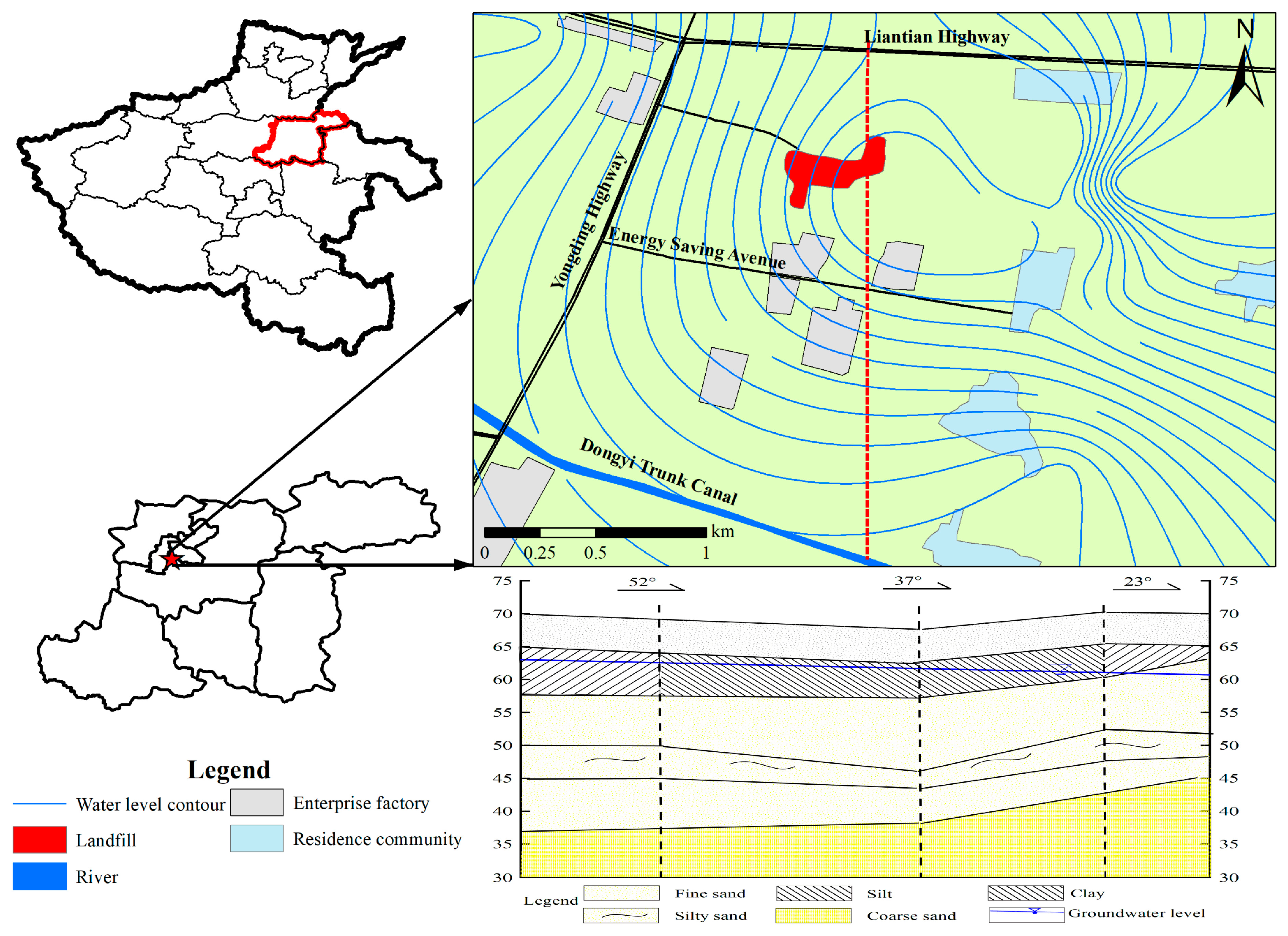
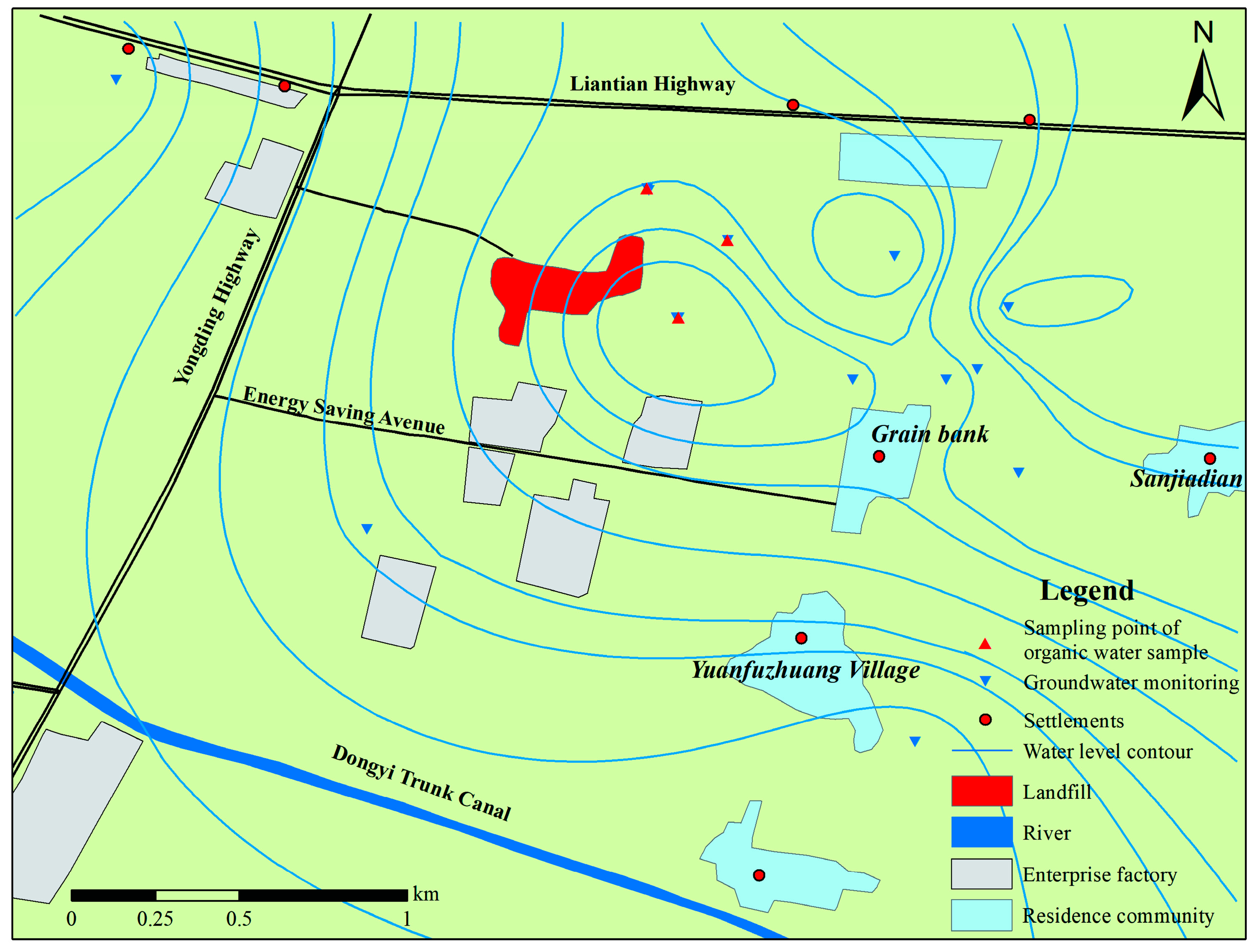
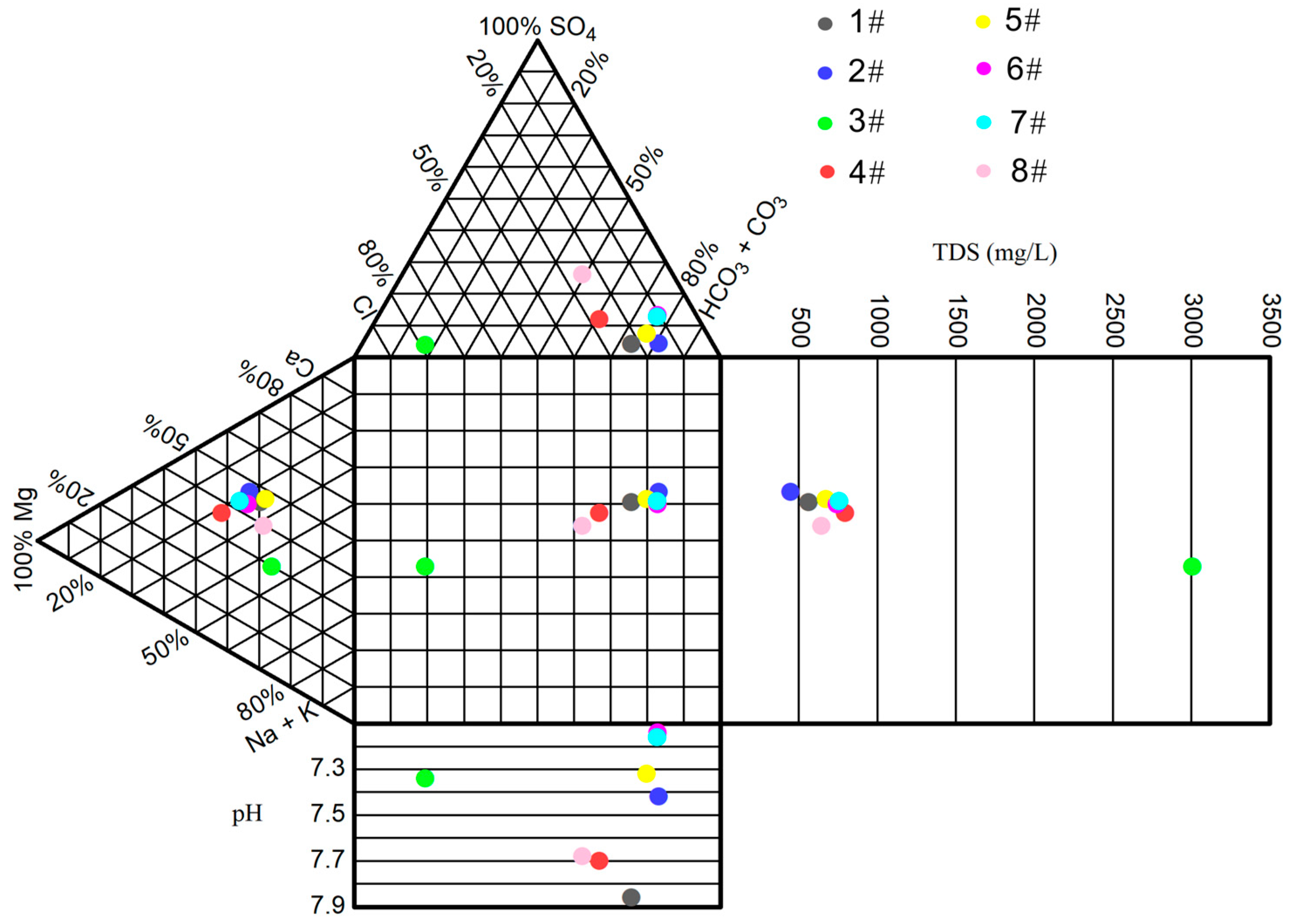
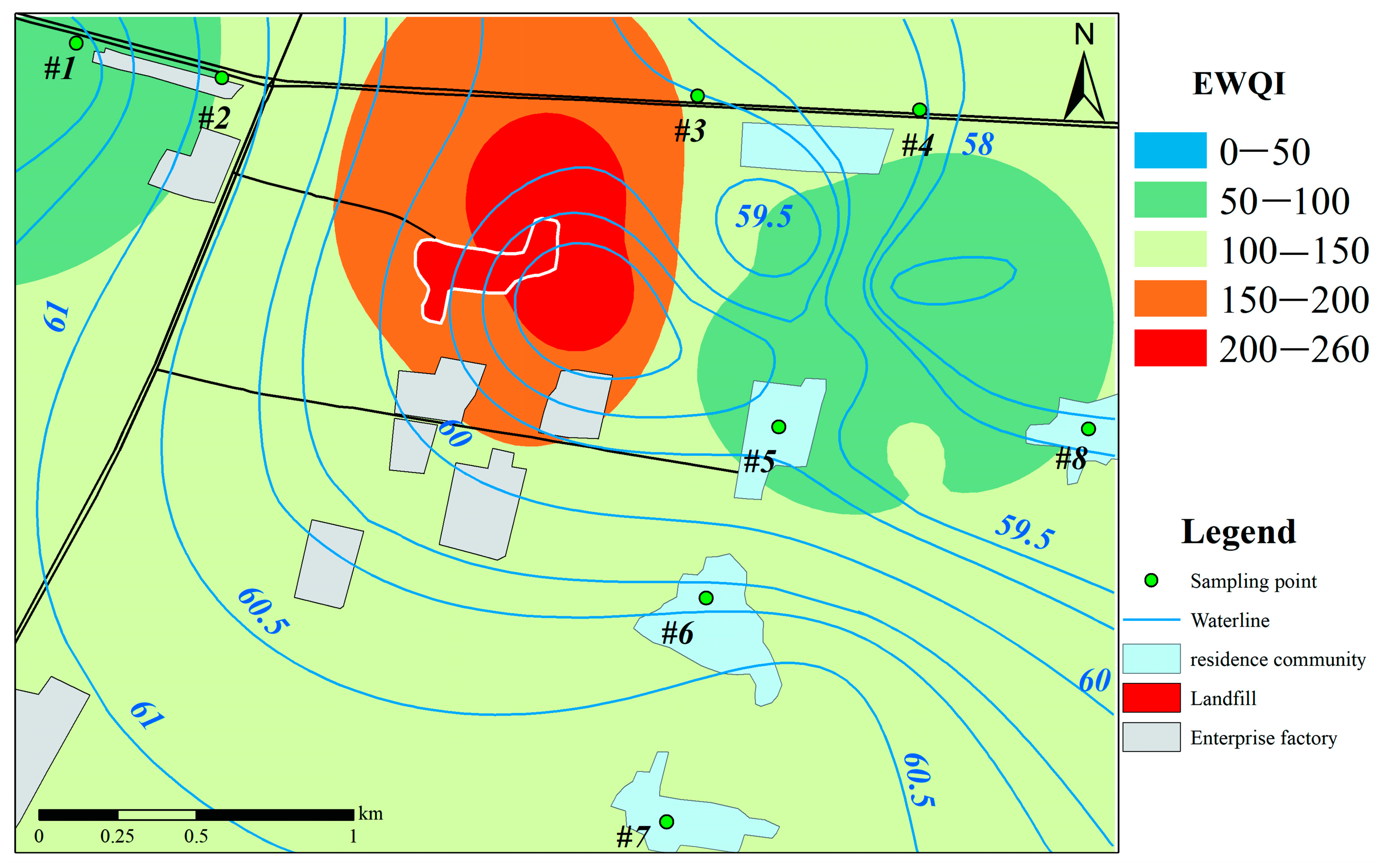
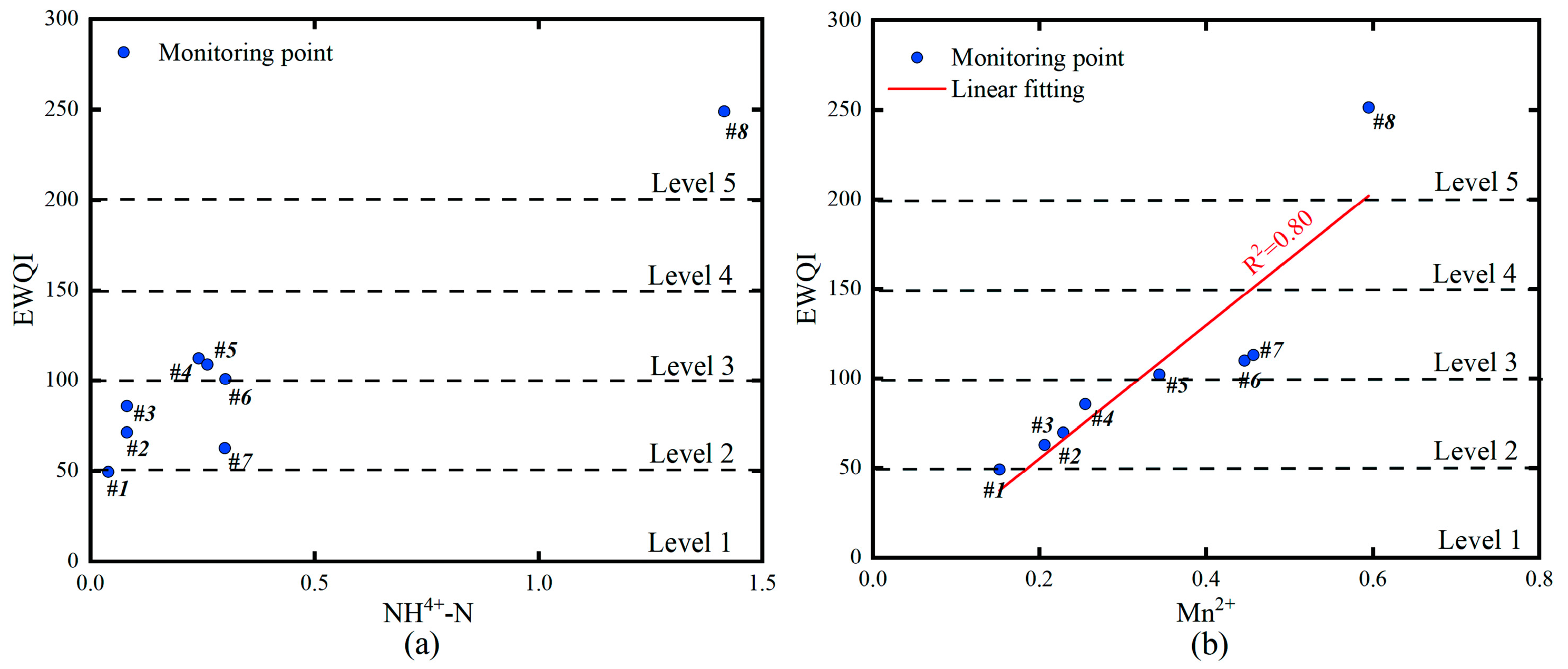
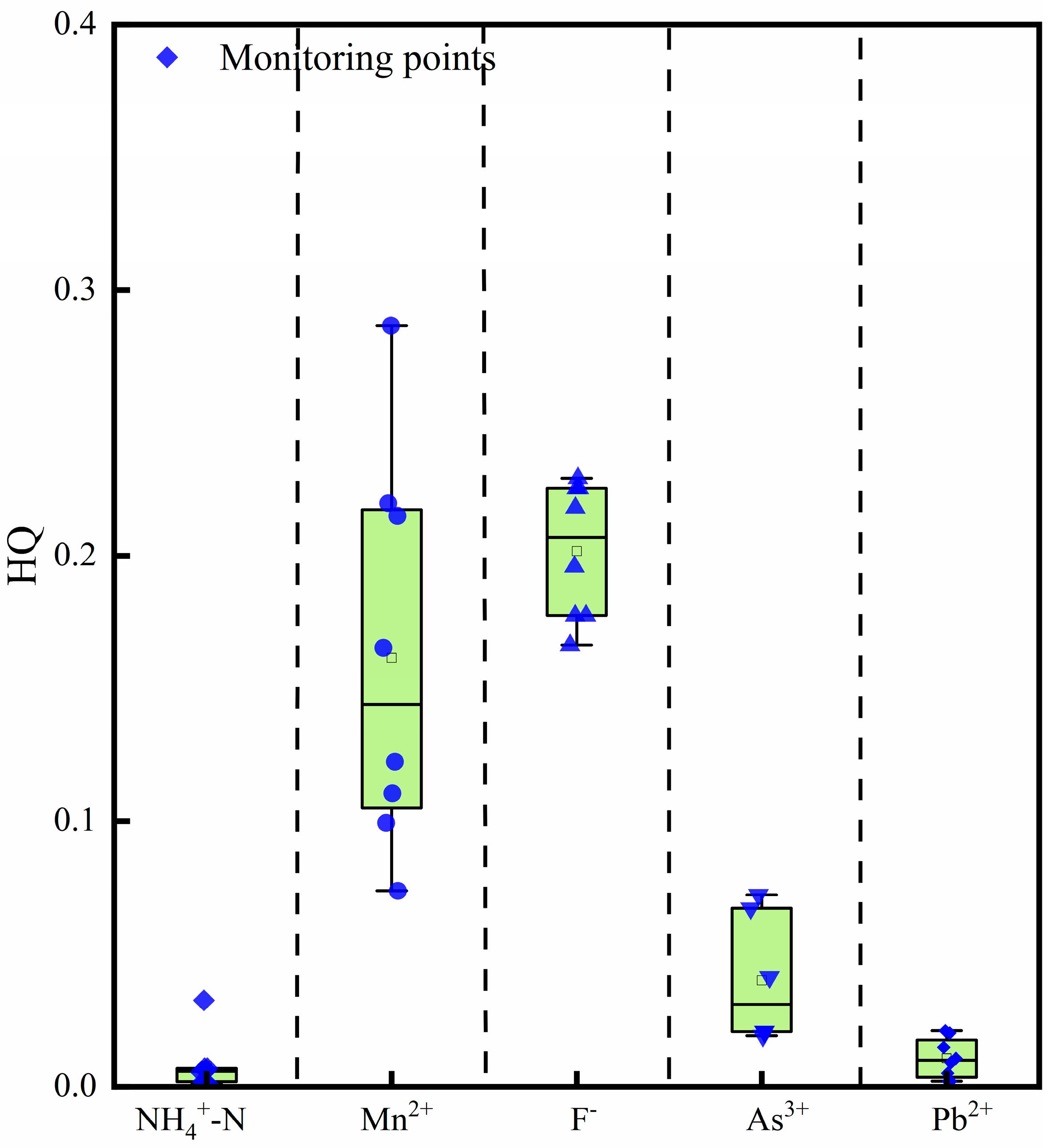
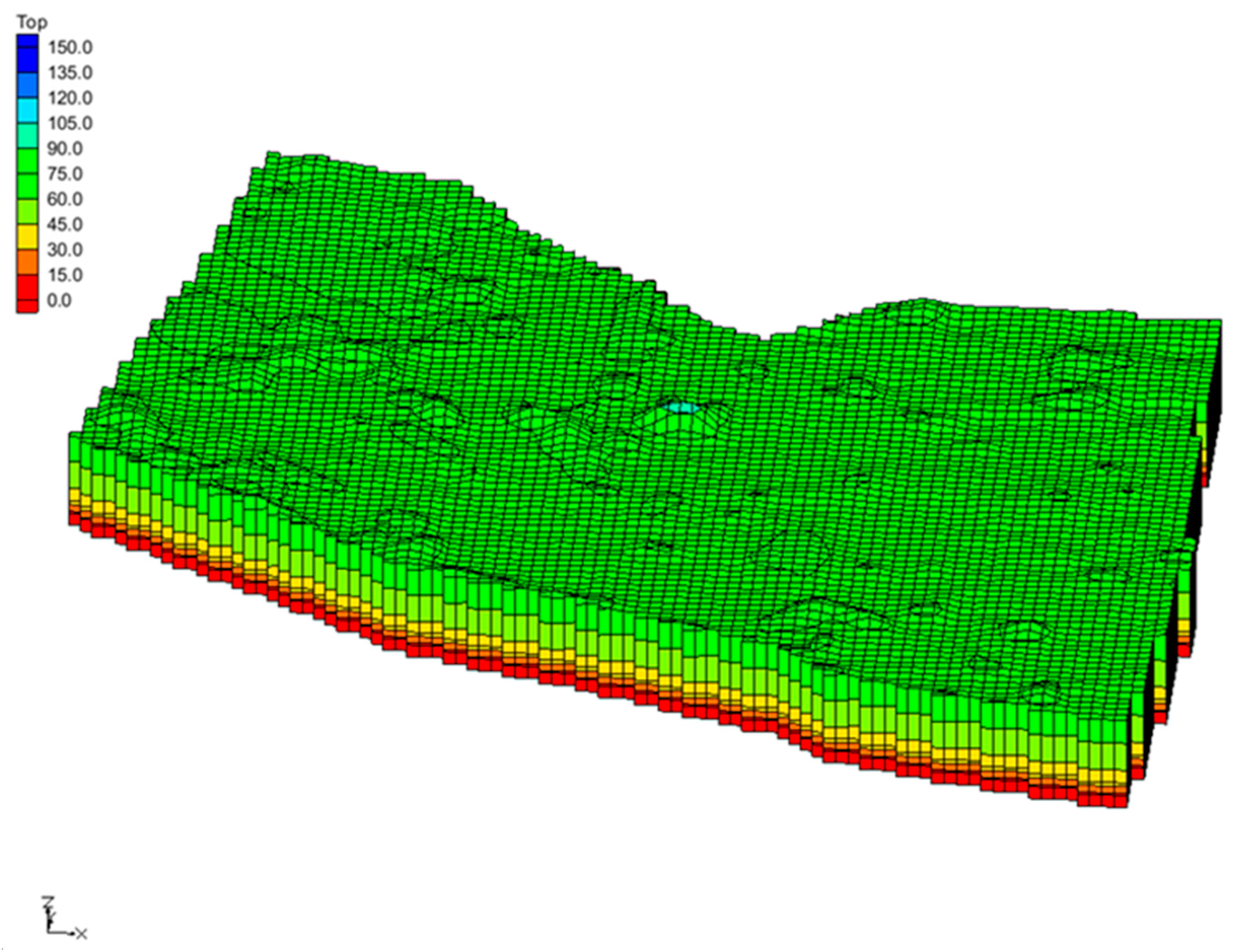
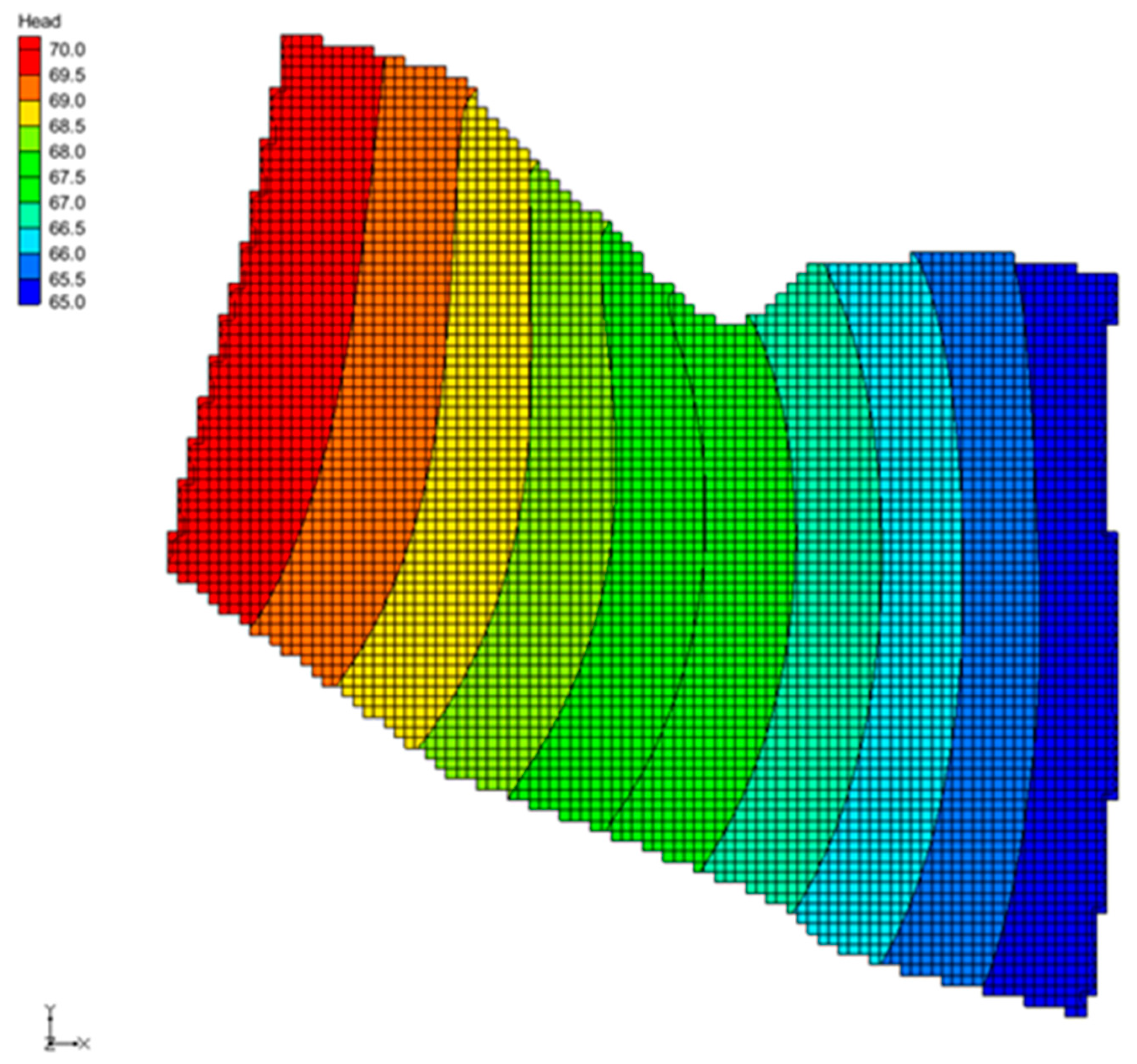
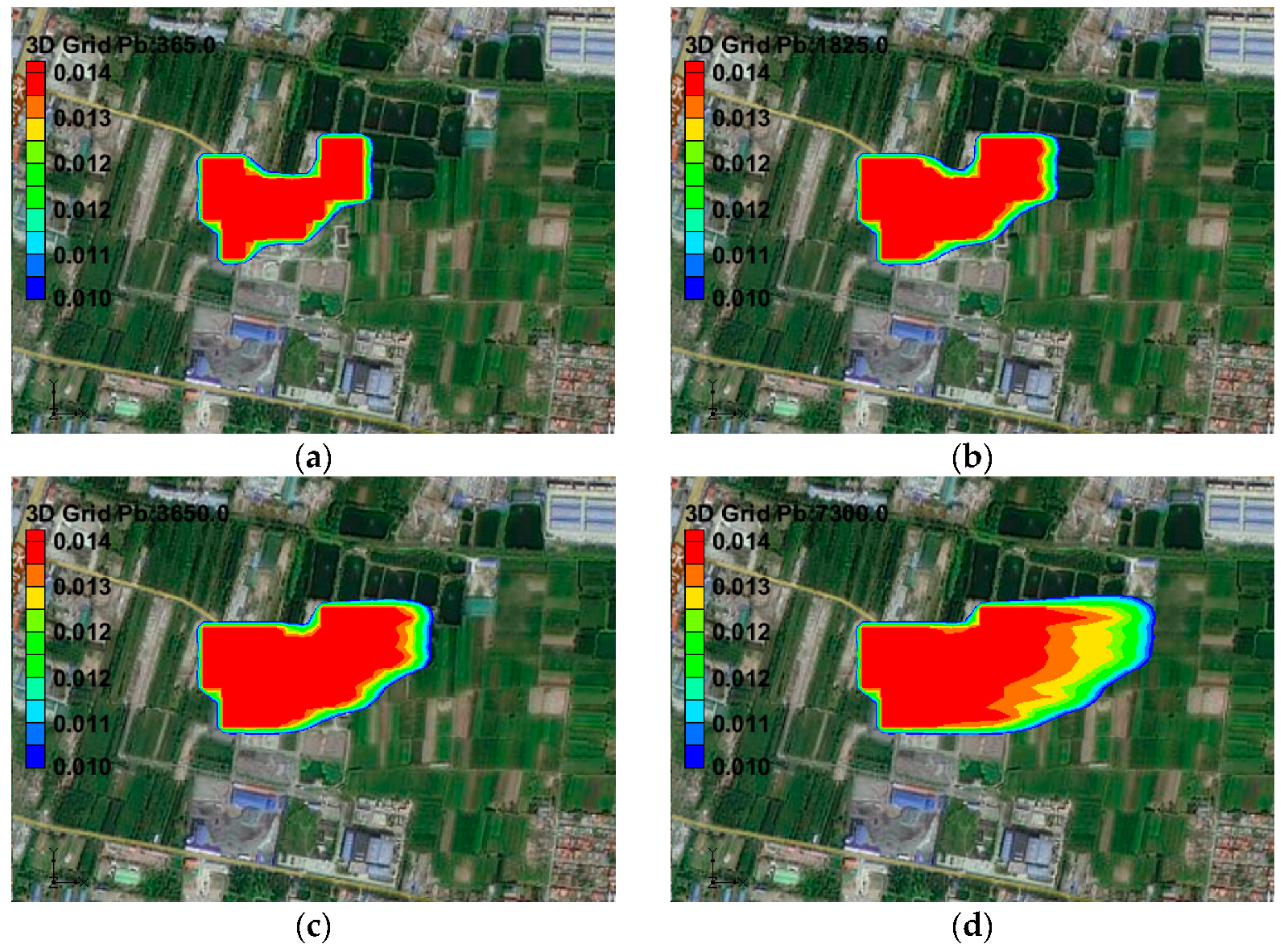
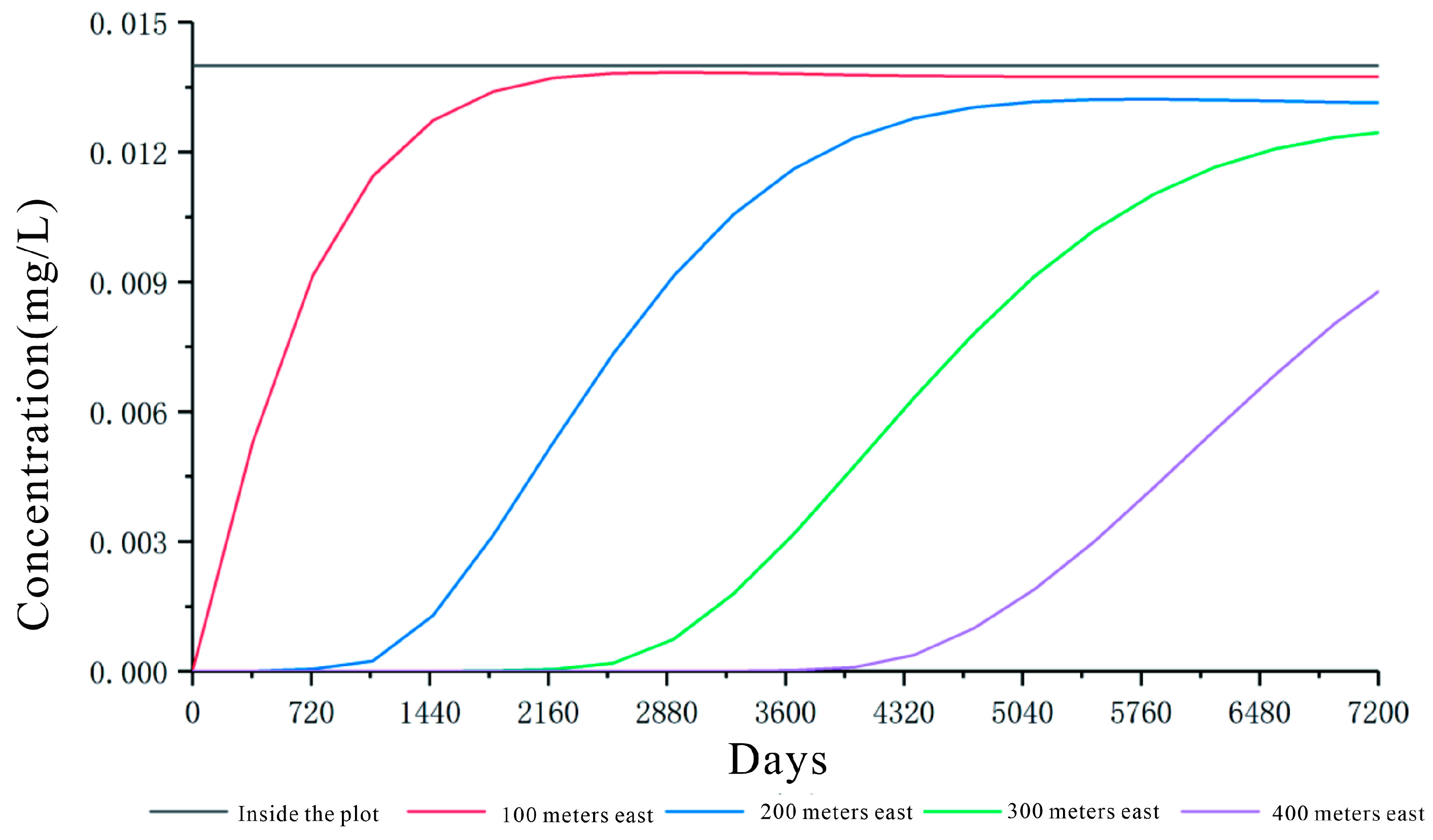
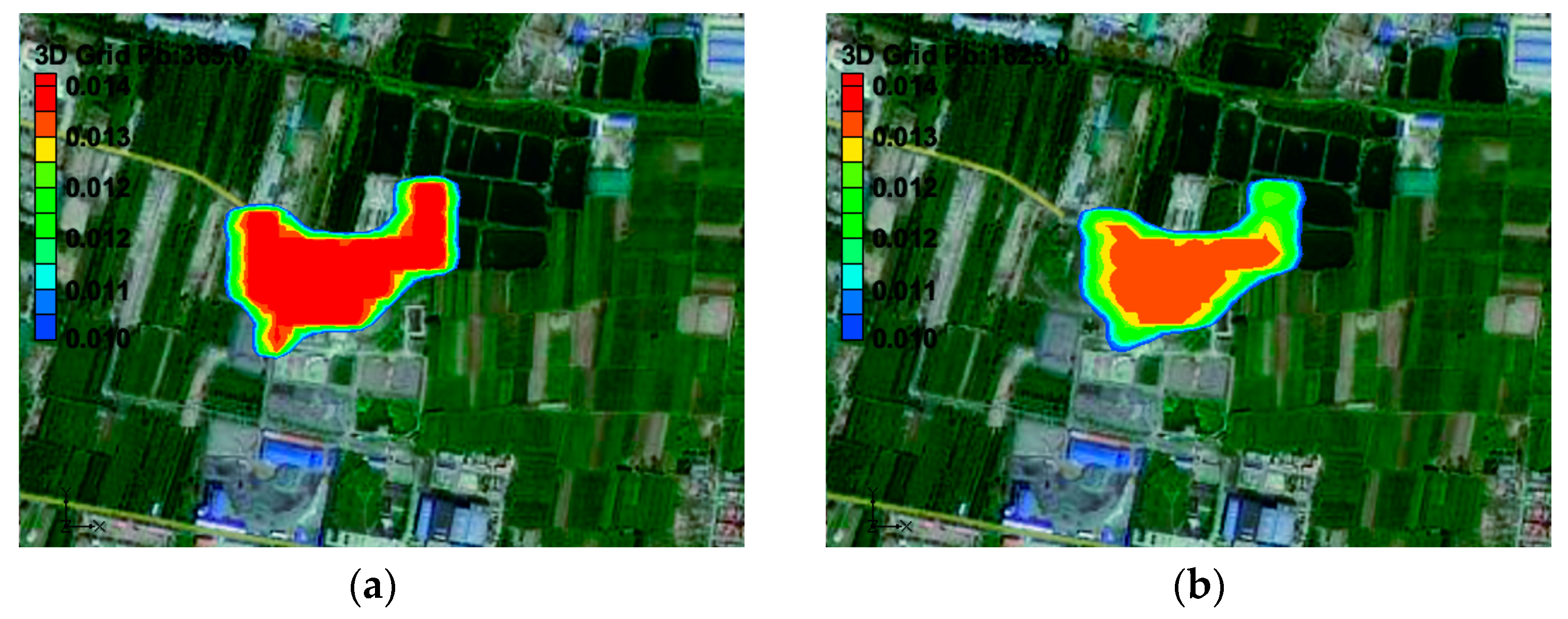
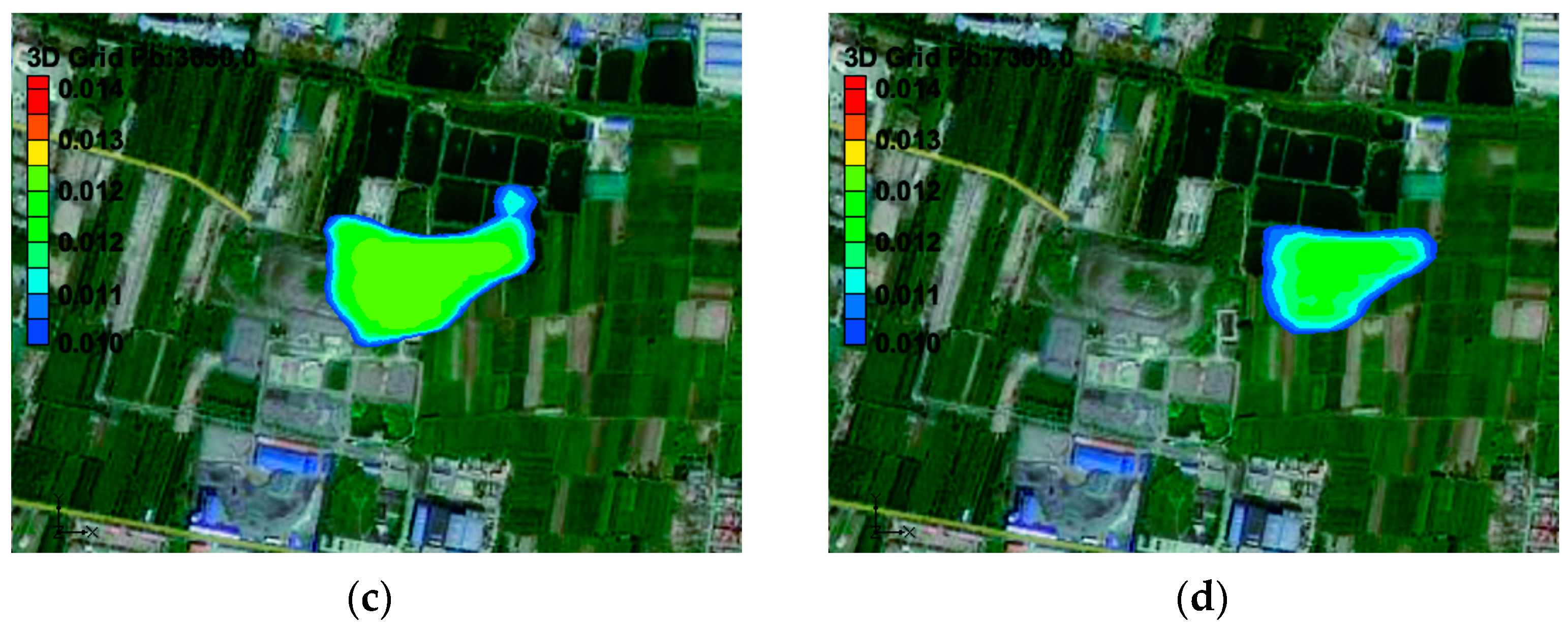
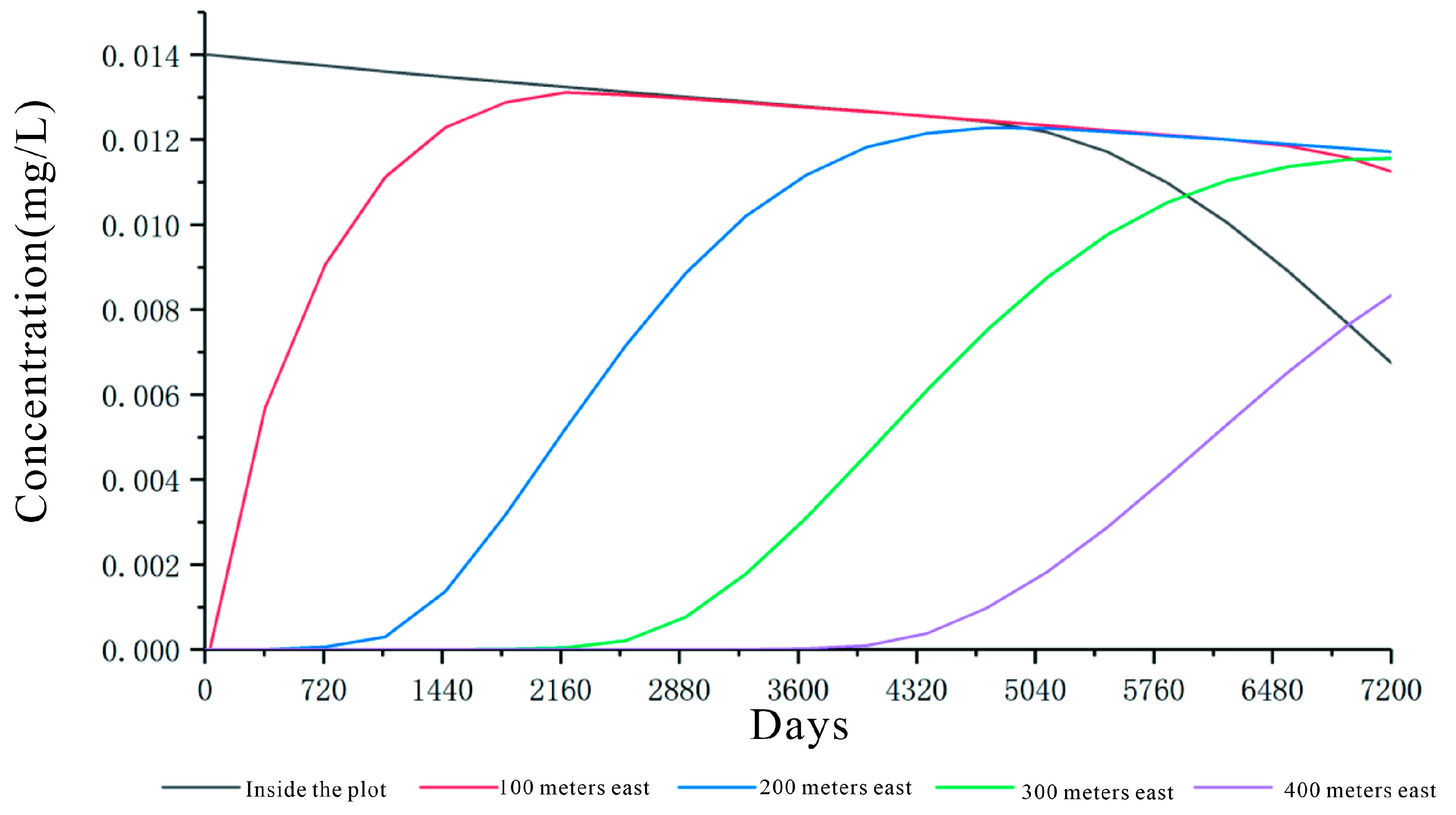
| EWQI | Grade | Description |
|---|---|---|
| ≤50 | 1 | Excellent |
| 50~100 | 2 | Good |
| 101~150 | 3 | Moderate |
| 151~200 | 4 | Poor |
| >200 | 5 | Very poor |
| Parameter | Description | Unit | Recommended Value |
|---|---|---|---|
| GWERa | Daily drinking water intake for adults | L·d−1 | 1 |
| EFa | Adult exposure frequency | d·a−1 | 250 |
| EDa | Adult exposure period | a | 25 |
| BWa | Adult body mass | kg | 61.8 |
| ATnc | Mean time to non-carcinogenic effects | d | 9125 |
| RfDo (NH4+-N) | Reference dose of ammonia nitrogen via oral intake | mg/(kg·d) | 0.97 |
| RfDo (Mn) | Reference dose of Mn via oral intake | mg/(kg·d) | 0.046 |
| RfDo (As) | Reference dose of As via oral intake | mg/(kg·d) | 0.0043 |
| RfDo (F−) | Reference dose of F− via oral intake | mg/(kg·d) | 0.06 |
| RfDo (Pb) | Reference dose of Pb via oral intake | mg/(kg·d) | 0.0035 |
| WAF | Reference dose distribution ratio for exposure to groundwater | Dimensionless | 0.5 |
| Parameter | Unit | Highest Level | Min. | Max. | Means | Standard Deviation | C.V. |
|---|---|---|---|---|---|---|---|
| pH | - | 6.5–8.5 | 7.140 | 7.860 | 7.453 | 0.266 | 0.036 |
| TDS | mg/L | 1000 | 446.000 | 3010.000 | 954.875 | 838.148 | 0.878 |
| K+ | mg/L | - | 0.944 | 13.600 | 3.237 | 4.276 | 1.321 |
| Ca2+ | mg/L | 200 | 79.800 | 274.000 | 124.450 | 63.009 | 0.506 |
| Na+ | mg/L | 200 | 39.100 | 458.000 | 114.050 | 139.539 | 1.223 |
| Mg2+ | mg/L | 50 | 34.200 | 145.000 | 61.250 | 37.303 | 0.609 |
| HCO3− | mg/L | 600 | 326.000 | 703.000 | 521.750 | 125.591 | 0.241 |
| Cl− | mg/L | 250 | 41.600 | 1090.000 | 200.625 | 360.672 | 1.798 |
| SO42− | mg/L | 250 | 16.500 | 130.000 | 64.600 | 37.788 | 0.585 |
| NH4+-N | mg/L | 0.5 | 0.040 | 1.420 | 0.340 | 0.449 | 1.321 |
| F− | mg/L | 1.2 | 0.450 | 0.620 | 0.546 | 0.069 | 0.127 |
| As | mg/L | 0.05 | 0.004 | 0.014 | 0.008 | 0.004 | 0.512 |
| Mn | mg/L | 0.1 | 0.153 | 0.595 | 0.335 | 0.152 | 0.454 |
| Pb | Mg/L | 0.01 | 0.002 | 0.021 | 0.011 | 0.00006 | 0.005 |
| Layer Number | Kh (m/d) | Kv (m/d) | μ | Longitudinal Dispersion | Lateral Dispersion |
|---|---|---|---|---|---|
| Level 1 | 12.87 | 1.28 | 0.2 | 4.42 | 0.442 |
| Level 2 | 3.87 | 0.39 | 0.15 | 1 | 0.1 |
| Level 3 | 12.87 | 1.28 | 0.2 | 4.42 | 0.442 |
Disclaimer/Publisher’s Note: The statements, opinions and data contained in all publications are solely those of the individual author(s) and contributor(s) and not of MDPI and/or the editor(s). MDPI and/or the editor(s) disclaim responsibility for any injury to people or property resulting from any ideas, methods, instructions or products referred to in the content. |
© 2023 by the authors. Licensee MDPI, Basel, Switzerland. This article is an open access article distributed under the terms and conditions of the Creative Commons Attribution (CC BY) license (https://creativecommons.org/licenses/by/4.0/).
Share and Cite
Mao, X.; Zhang, S.; Wang, S.; Li, T.; Hu, S.; Zhou, X. Evaluation of Human Health Risks Associated with Groundwater Contamination and Groundwater Pollution Prediction in a Landfill and Surrounding Area in Kaifeng City, China. Water 2023, 15, 723. https://doi.org/10.3390/w15040723
Mao X, Zhang S, Wang S, Li T, Hu S, Zhou X. Evaluation of Human Health Risks Associated with Groundwater Contamination and Groundwater Pollution Prediction in a Landfill and Surrounding Area in Kaifeng City, China. Water. 2023; 15(4):723. https://doi.org/10.3390/w15040723
Chicago/Turabian StyleMao, Xiaoming, Shengyan Zhang, Shuhong Wang, Tengchao Li, Shujie Hu, and Xiaoqing Zhou. 2023. "Evaluation of Human Health Risks Associated with Groundwater Contamination and Groundwater Pollution Prediction in a Landfill and Surrounding Area in Kaifeng City, China" Water 15, no. 4: 723. https://doi.org/10.3390/w15040723




